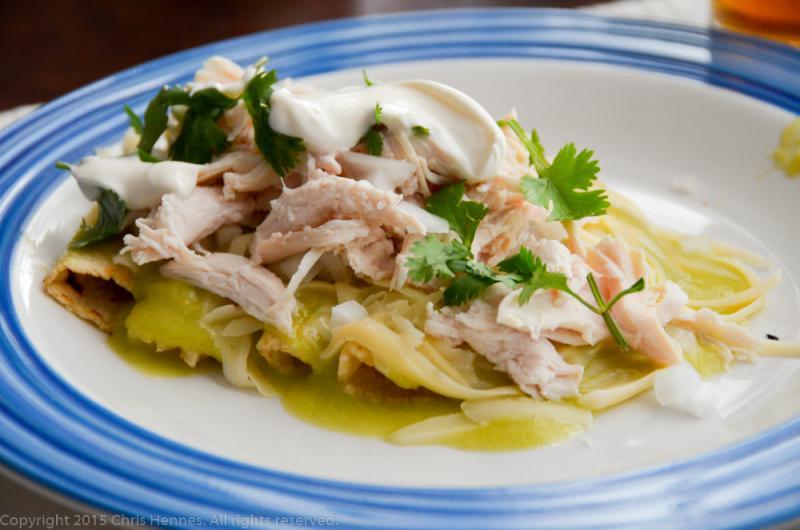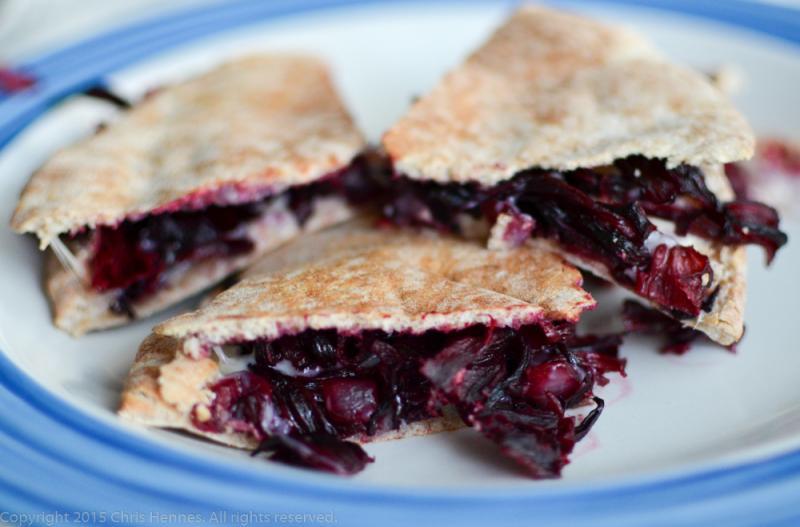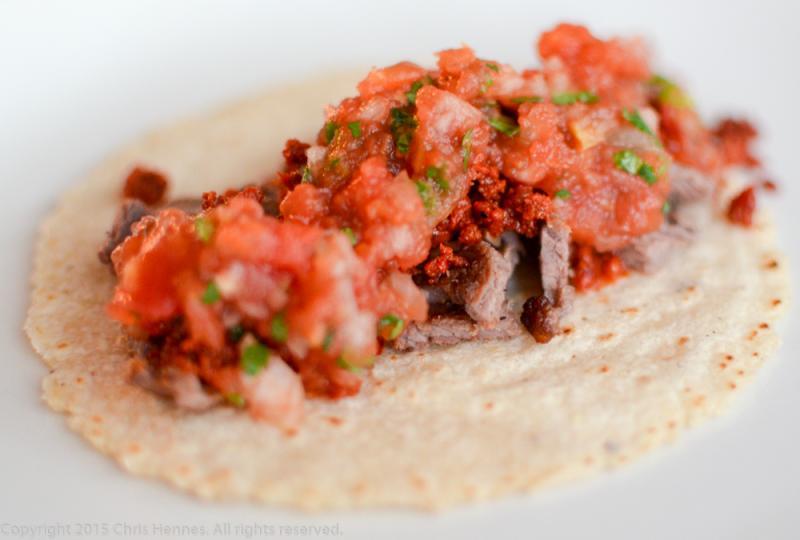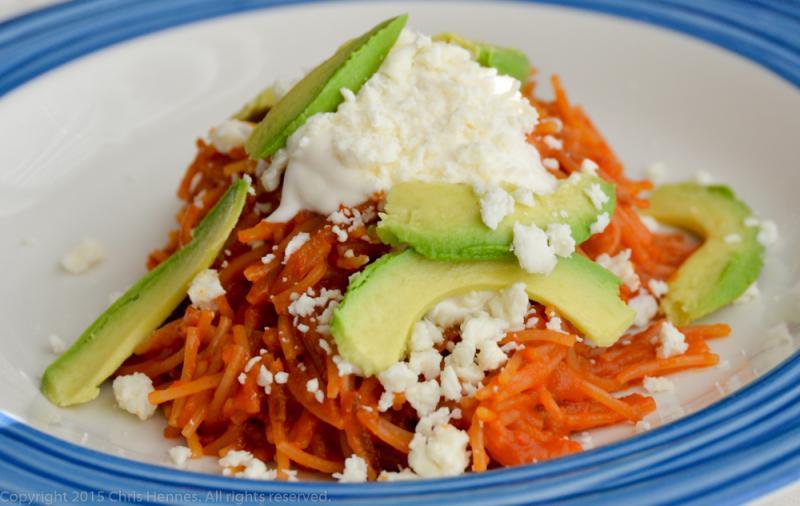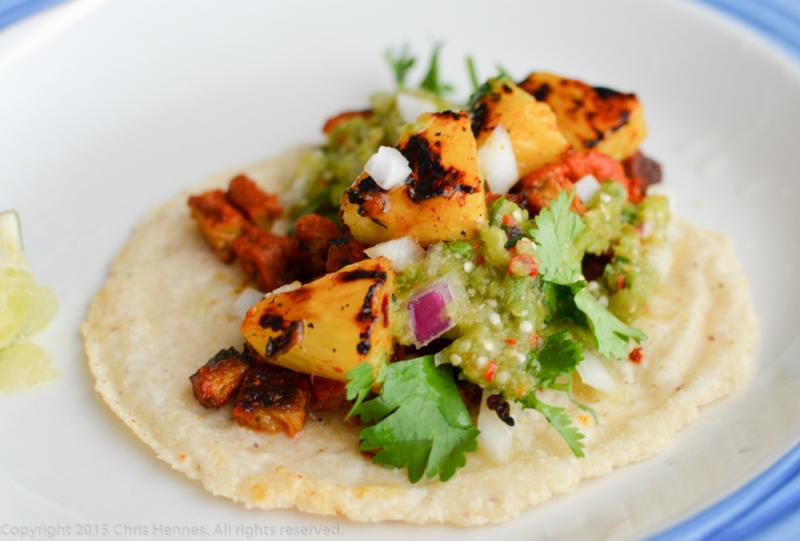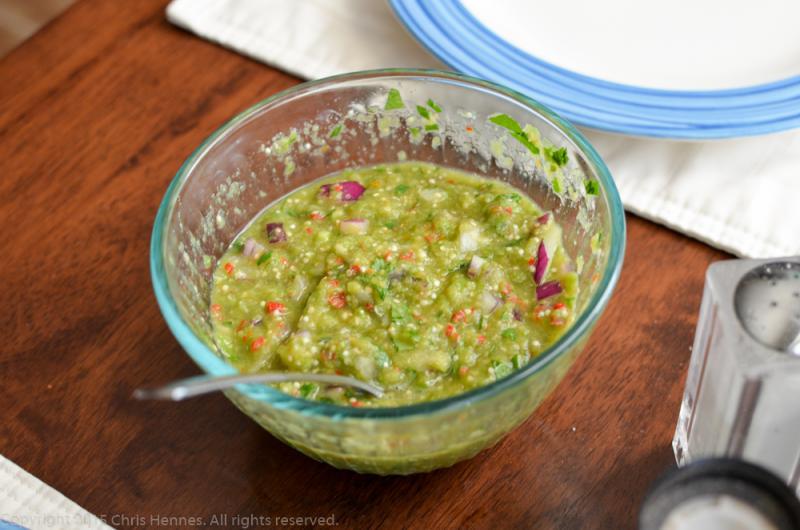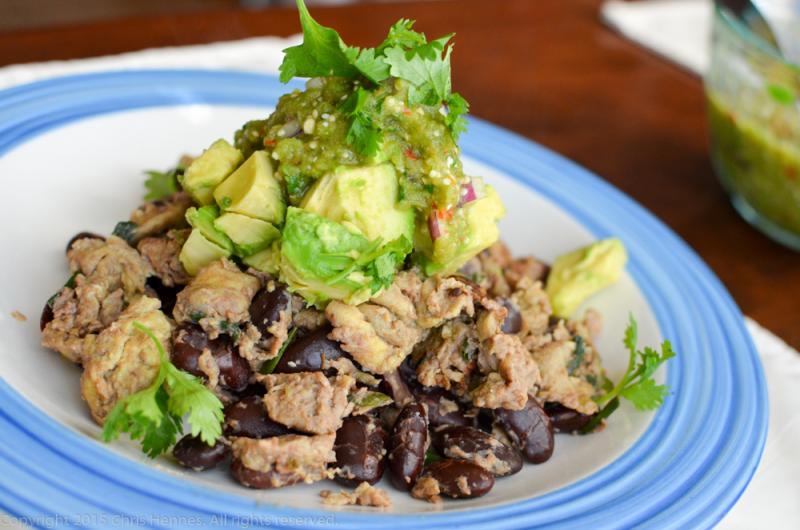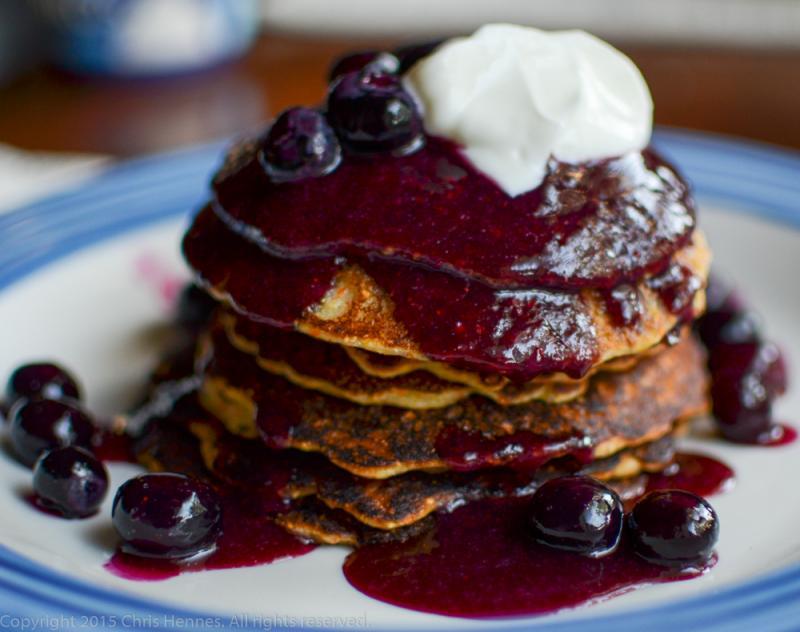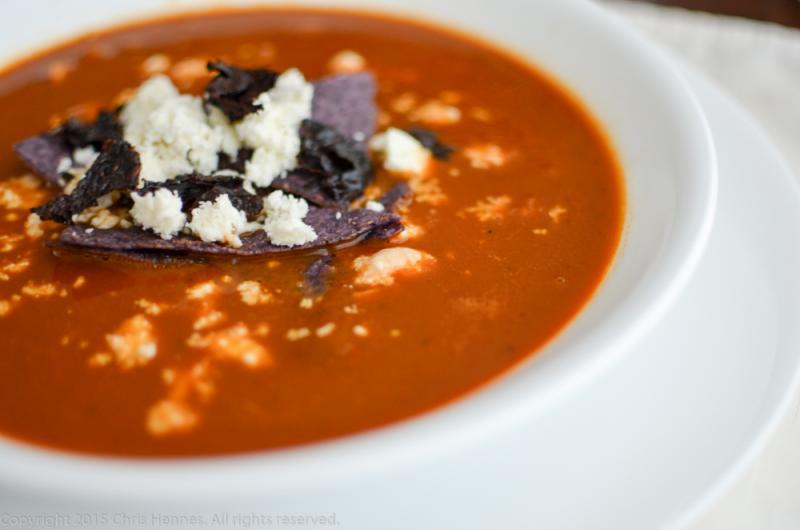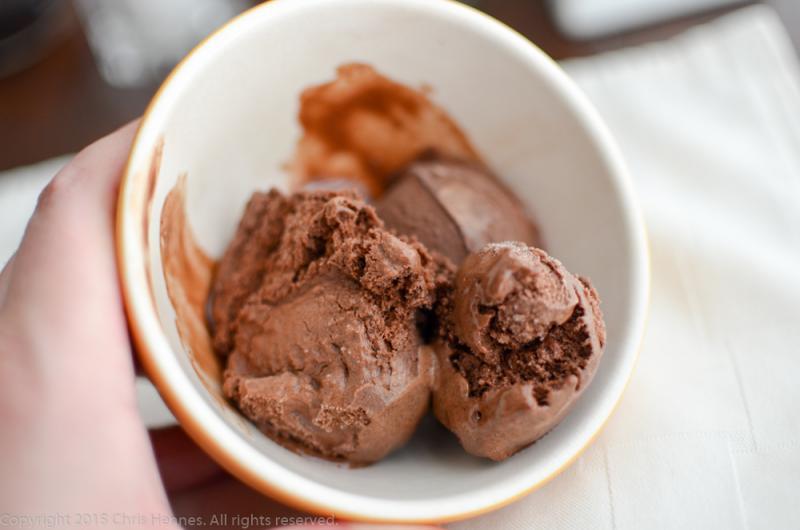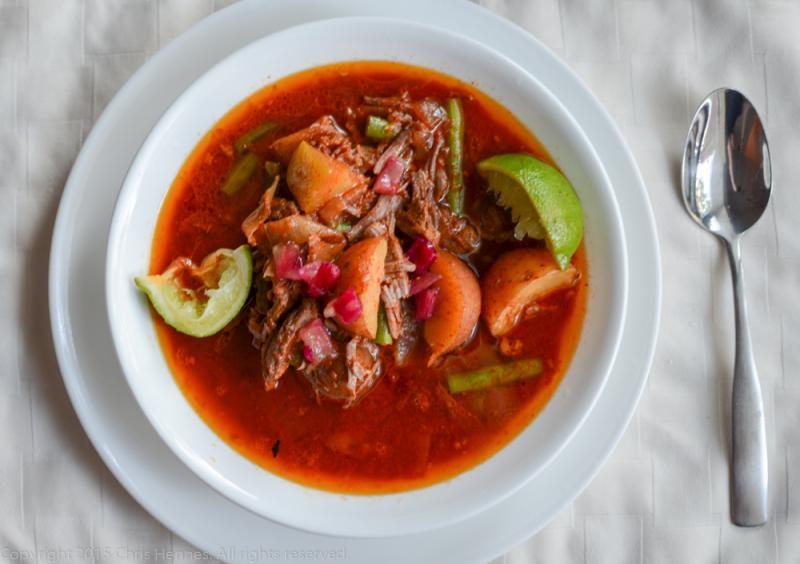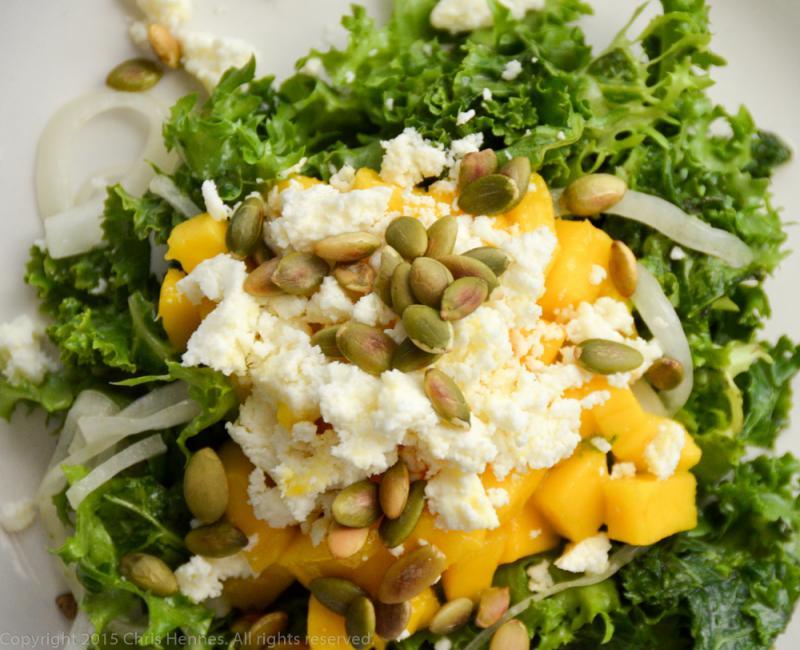-
Posts
10,190 -
Joined
-
Last visited
Content Type
Profiles
Forums
Store
Help Articles
Everything posted by Chris Hennes
-
Enchiladas Verdes (p. 50) Green chicken enchiladas Her version of Enchiladas Verdes is pretty typical, except that hers aren't rolled. She also demonstrates her fondness for "picante" with the inclusion of two unseeded serrano chiles, which definitely add some kick. I thought that making it with a quick stock while cooking the chicken worked reasonably well and overall kept the dish feeling light, with a bright acidity and spiciness.
-
Hibiscus Flower Quesadillas (p. 164) Normally I think you use hibiscus flowers to brew a liquid, and then discard the flowers (at least, that's how I've used them in the past). In this recipe, you actually use the flowers themselves. First they get rinsed, then steeped for three minutes, then rinsed again, and finally sauteed with onions and Serrano peppers before being finished in the oven with jack cheese and pitas. It's an interesting idea, that unfortunately didn't work for me. In particular, the flowers were still much too chewy and firm after only the three minute steep. I thought maybe they'd improve over the course of the rest of the cooking, but they didn't. It's interesting to me that Téllez even comments that US hibiscus flowers are softer than the ones she can get in Mexico, and that she prefers the firmer texture she gets there. I wonder if the flowers I've got were firmer than the ones she is used to using in the US. The flavors were fine (not awesome, but worth eating), but the texture really dragged this down into the basically inedible category.
-
Tacos Campechanos (p. 80) Steak and Chorizo Tacos The beef I buy here in Oklahoma City labelled "cecina" is I think actually just the base product used to make what Téllez describes as cecina in the book. Mine was neither salted nor dried. I am not sure how much this mattered, I simply salted it myself and then cooked it over very high heat on the grill until it got sort of crispy and charred. It's served with chorizo and a very spicy Pico de Gallo. In a dish like this one I am particularly thankful for the amazing chorizo at Morelo's (if you are in the OKC area you should come down to Moore and check it out). Overall the dish was excellent, and also very easy to make on a weeknight.
-
Sopa Seca de Fideo (p. 102) Fideo Noodles in Chipotle-Tomato Sauce I think once you've got the avocados on there this is fair game for a main course, which is how I served it. I really like fideos, particularly the spicier varieties like this one, featuring a lot of chipotle chiles and then cooled off with cheese and crema on top. I've never served it with avocados before, but they were good. The recipe also calls for an optional topping of chicharrones, which I didn't have, but will probably make a point of including next time.
-
The rolls are called "telera rolls" and they were purchased from (and baked at) the mercado where I get the bulk of my Mexican ingredients. They are similar in texture to a supermarket-style "French bread" but are perhaps a bit sweeter. The ones I can buy look pretty similar to the ones pictured in the book, but at Tortas Bayless uses what I presume to be a more "artisan"-style version that is a bit denser and crustier.
-
Pambazos (Fried Chorizo and Potato Sandwiches) (p. 70) These were particularly interesting to me in their construction technique: the outside of the bread is brushed with a thin guajillo chile sauce before being fried in lard. This gave a nice burst of flavor even before you hit the chorizo and potato filling, which itself is one of Mexico's greatest culinary creations. I used the house-made chorizo from tour local mercado, which was terrific. I'm sure the iceberg is an authentic touch to this street food, but I do like her idea of replacing it with radish greens and cilantro, which I think I will try next time.
-
Tacos al Pastor (p. 49) I've never been to Mexico City, so my comments on these recipes are by definition just my personal taste, not a comparison to some "gold standard". I figured I'd start out with something that I've at least eaten several times at various taquerias so I had something to benchmark against, however, and tacos al pastor is ubiquitous. I've had versions I liked and versions I loved, and my taste runs toward the high ratio of crispy bits to chewy bits when it comes to the pork. So I cooked my pork on the grill over high heat, and let it char a bit more deeply than the recipe might suggest. But otherwise I stuck to the letter of the thing. The marinade and marination time were great, giving the pork a deep achiote flavor without completely losing the pork. Without a side-by-side comparison it's hard to say if this was the best I've ever had (though ultra-fresh tortillas certainly swing things in my favor...) but it ranks right up there, despite not being slow-roasted on a vertical spit. A very solid first attempted recipe for this book.
-
Salsa Verde Cruda (p. 26) The first thing I made from the book was a salsa to accompany this dish from Bayless's More Mexican Everyday. It's made with completely raw tomatillos, and she suggests using the tiny ones (sold here as "miltomates") which I had never used before. It also calls for nine fresh árbol chiles to ten ounces of tomatillo, which had me a bit nervous about the heat level. In the end it turned out very spicy, but not outrageously so. I was glad I grow árbol's though, since I've never seen them sold fresh. I think the tiny tomatillos are more tart than the big ones, and leaving them raw definitely gives the salsa a very acidic edge, which I thought was great.
-
Scrambled Eggs with Beans, Green Onions and Avocado (p. 286) The ideas are good here, but I wasn't enamored of the execution. The recipe has you cook the eggs in a pan with the beans, which even with well-drained beans is going to color the eggs, as well as making them harder to manage and cook properly. Of course the flavors aren't affected, and the dish tasted good (thanks in no small part to a salsa from Lesley Téllez's Eat Mexico), but I think simply topping scrambled eggs with the beans and avocado would have resulted in a better dish. This is pretty much it for me and this cookbook for the time being: there are several recipes that call for things that are out of season right now, and a few that call for various bits of seafood that my wife doesn't care for. Anyone out there with the book want to take a stab at any of those?
-
Has anyone else picked up a copy of Lesley Téllez's new cookbook, Eat Mexico? I've long wanted to take a culinary tour of Mexico City, but I still haven't made it down there; this book is doing nothing to calm that desire! There are quite a few ingredients in it that I am going to have a hard time getting my hands on, but I thought I'd give some of the recipes a try anyway. Is anyone else cooking from it yet?
-
Did you use rice or breadcrumbs?
-
I had dinner at Topolobampo last night, and recognizing so many of the dish components from his cookbooks made it a particularly fun meal. It also reminded me of this post, since the final dessert course was this cake. But of course considering the caliber of the restaurant it wasn't plated quite like the cookbook suggests! They served it in small chunks with a chocolate sorbet (or maybe ice cream?), a dried-chile crema, and caramel-glazed pumpkin seeds. I thought the crema was too assertive, but of course was happy to see those glazed seeds.
-
Cornmeal Pancakes (p. 237) I've posted about these before, but last time I used his Cinnamon Agave syrup as the topping. This time I took a page from the eGullet playbook and made a cooked/uncooked blueberry topping. From Bayless I get the idea that Greek yogurt should be a staple and a dollop makes many things better. I also used the smaller quantity of buttermilk in the recipe, and omitted the butter from the cooking pan entirely. Personally I found this iteration to be more successful, with the fresh blueberries and Greek yogurt providing a superior foil for the crunchy cornmeal texture.
-
He describes the dish as "Veracruz style" in his discussion of the mutual influence of Mexican and Mediterranean cuisines.
-
Braised Artichokes with Tomatoes, Jalapenos, Olives and Capers (p. 218) It was interesting to me to see this in a Mexican cookbook, since the flavor profile is not one that I typically associate with Mexico. Which I suppose goes to show how little of the country's food I am actually familiar with! I would have liked quite a bit more of the pickled jalapeno than the recipe calls for, but I'm a sucker for the things, and I have a huge jar left from last year. This year's jalapeno crop will be ready for canning soon, so I need to get cracking on them.
-
Silky Tortilla Soup (p. 285) This soup is an ancho chile, beans, roasted tomatoes, and stock, pureed and then topped with tortilla chips, queso fresco, and toasted bits of ancho. I was a bit suspicious of the toasted crumbled ancho topping, since last time I tried it I was not so successful, but this time I took more care in the toasting and really got them crispy. The result was a much better texture with a great pop of dried chile flavor when you bit into them.
-
Mexican Chocolate Sorbet (p. 350) I was really surprised by the ice cream-like texture of this sorbet. It has no dairy in it, so I expected some iciness, but there really wasn't any. What you get is a really aggressive, pure chocolate taste. There's nothing else in there getting in the way, so the flavor release is exceptional. I used the Taza Puro 70% as the Mexican chocolate, and Valrhona as the cocoa powder. The only other ingredients were sugar, water, and vanilla extract (I went with a homemade Tahitian). The quality of the ingredients paid off, this sorbet is fantastic.
-
Red Chile Short Rib Soup (p. 272) This soup did taste good, but honestly the best part was the smell: the whole house smelled like braising beef and chiles. At first glance this seemed like a conventional enough beef braise, but the effect of including chayote, xonocostles (prickly pear cactus fruits, a.k.a. "tuna verde"), and epazote resulted in a unique texture and flavor. I think I'd prefer the green beans cooked a bit more, but overall I liked the dish.
-
I'm not trying to make my own tonic water, I'm rather fond of the brands I've got actually.
-
Exactly so: I'm always surprised to find that it's still fizzy, under conditions where a bottle of soda would be completely flat.
-
It seems to me that tonic water, or at least the Schweppes I've got right now, retains its fizz better than pretty much any other carbonated beverage. I can leave the bottle open overnight, and when I go to dump it the next day it's still going strong. Capped and put back into the fridge it seems to retain full fizziness for days on end, unlike soda which invariably tastes flat after a day or two. What's going on here?
-
I used mustard greens, green kale, and escarole.
-
"Sturdy Greens" Salad with Mango and Habanero (p. 138) This is a relatively sweet salad that I think would be a great "exotic" salad course for guests. It contains a good mix of sweet and acidic ingredients, and slightly unusual greens. It's not something that appears on that many menus, but fills the same sort of slot as the near-ubiquitous spinach-strawberry-poppyseed salads.
-
Absolutely, but remember that the vast majority of that advice is directed at your standard home burger-maker using supermarket ground beef. The reason for the advice is that mixing the meat, particularly after adding salt, causes the formation of myosin. In small quantities that myosin is what holds your burger together. In large quantities it's what turns your burger into a hockey puck. The reality is that there is a sweet spot where you have enough that your burger holds shape, but not so much that it becomes tough. In my opinion if you are grinding your own meat you can and should work it a bit if you want your burger to be a burger and not sloppy joes!



